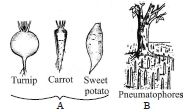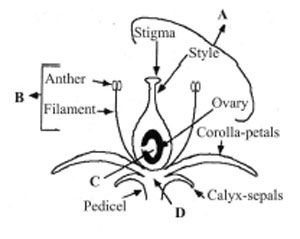Which one of the following structure is not associated with gynoecium?
Ovary
Style
Stigma
Filament
Correct Answer :
D. Filament
Gynoecuim or pistil is the female whorl that is differentiated into the ovary, style and stigma. Androecium is the male reproductive organ consisting of stamen. Each stamen is distinguishable into anther and filament joined by a connective.
Related Questions
Most prominent function of inflorescence is
dispersal of seeds.
formation of more fruits.
formation of pollen grains.
dispersal of pollens.
During the post-fertilization period, the ovules develops into ___A____ and the ovary matures into a ___B ____.
A - seeds; B - fruit
A - fruit; B - seeds
A - flower; B - seed
A - seeds; B - flower
Match column-I with column-II and choose the correct option.
| A. Gram, sem, moong, | I. Medicine soyabean |
|---|---|
| B. Soyabean,groundnut | II. Ornamental |
| C. Indigofera | III. Fodder |
| D. Sunhemp | IV. Fibres |
| E. Sesbania, Trifolium | V. Dye |
| F. Lupin, sweet potato | VI. Edible oil |
| G. Mulethi | VII. Pulses |
A I, B II, C III, D IV, E V, F VI, G VII
A VII, B VI, C V, D IV, E III, F II, G I
A II, B IV, C VI, D I, E III, F V, G VII
A I, B III, C V, D VII, E II, F IV, G VI
Which type of function is performed by the fleshy leaves of onion and garlic?
Storage
Reproduction
Photosynthesis
Protection
Root hairs develop from
region of maturation
region of elongation
region of meristematic activity
root cap
Which of the following groups of plants have underground stems?
Potato, ginger, turmeric, Euphorbia, zaminkand
Potato, ginger, turmeric, zaminkand, Colocasia
Potato, Citrus, Opuntia, zaminkand, Colocasia
Potato, cucumber, watermelon, zaminkand, Colocasia
The given figures (A and B) shows the modificaiton of roots.Which of the following statements regarding the figures is correct ?

Tap roots of carrot, turnip and adventitious root of sweet potato, get swollen and store food.
Pneumatophores conducts water, minerals & photosynthesis
Pneumatophore is found in the plants that grow in sandy soil.
Turnip & carrot shows adventitious roots and sweet potato shows tap root.
Which of the following statements are correct?
- From the region of elongation, some of the epidermal cells form root hairs.
- Pneumatophores are seen in Rhizophora.
- Adventitious roots are seen in the banyan tree.
- Maize and sugarcane have prop roots.
(i) and (iv)
(i), (iii) and (iv)
(iii) and (iv)
(ii) and (iii)
Match column - I, II and III and choose the correct option.

A - V, t; B - II, s; C -I, r; D -III, q; E -IV, p
A - I, t; B - II, s; C - III, r; D - IV, p; E - V, q
A - V, p; B - II, s; C - I, q; D - III, r; E - IV, t
A - V, p; B - III, q; C - II, s; D - I, t; E - IV, r
The region of the root-tip which is involved in the formation of root hairs by epidermal cells is called the
region of maturation.
region of meristematic activity.
region of elongation.
none of the above.
Which of the following represents the floral characters of liliaceae?
Six tepals, zygomorphic, six stamens, bilocular ovary, axile placentation.
Actinomorphic, polyphyllous, unilocular ovary, axile placentation.
Tricorpellary, actinomorphic, polyandrous, superior ovary, axile placentation.
Bisexual, zygomorphic, gamophyllous, inferior ovary, marginal placentation.
In flower (X), the gynoecium occupies the highest position while the other parts are situated below it. The ovary in such flowers is said to be Y. Identify X and Y and select the correct option.
X - Epigynous, Y - Inferior
X - Perigynous, Y - Superior
X - Hypogynous, Y - Superior
X - Perigynous, Y - Half-inferior
Match column I with column II and choose the correct combination from the options given below.
| (Position of floral parts on thalamus) | (Represented in) |
|---|---|
| A. Hypogynous | I. Ray florets of sunflower |
| B. Perigynous | II. Brinjal |
| C Epigynous | III Peach |
A II, B I, C III
A I, B II, C III
A III, B II, C I
A II, B III, C I
Which of the following is correct with reference to floral character of family solanaceae?
Racemose, zygomorphic, unisexual, floral characters
Racemose, zygomorphic, bisexual, polypetalous
Axillary, bisexual, actinomorphic, epipetalous
Axillary, actinomorphic, bisexual, epipetalous
A branch in which each node bearing a rossette of leaves and a tuft of roots is found in aquatic plants like _________ and _________.
Hydrilla and Pistia
Eichhornia and Hydrilla
Pistia and Eichhornia
Pistia and Vallisneria
A scar on the seed coat through which the developing seeds attached to the fruit is called as ________.
testa
tegmen
hilum
micropyle
The given figures (A & B) show two types of compound leaves. Choose the option which identity the correct compound leaf and their example (c).

A - Pinnately compound leaf, C - Neem
A - Palmately compound leaf, C - Neem
B- Pinnately compound leaf, C - Silk cotton
B- Palmately compound leaf, C - Silk cotton
Which one of the following option shows the correct labelling of the structure marked as A, B, C & D?

A - Gynoecium, B - Megasporophyll, C - Ovule, D - Thalamus
A - Gynoecium, B - Stamen, C - Seed, D - Thalamus
A - Microsporophyll, B - Stamen, C - Ovule, D - Thalamus
A - Gynoecium, B - Stamen, C - Ovule, D - Thalamus
The region of the stem where leaves are born are called ____________ while ____________ are the portions between two ____________.
nodes, nodes and internodes
nodes, internodes and nodes
internodes, nodes and nodes
internodes, internodes and nodes
Floral features are chiefly used in angiosperms identification because
flowers are of various colours.
flowers can be safely pressed.
reproductive parts are more stable and conservative than vegetative parts.
flowers are good materials for identification.
The X is small and situated in a groove at one end of the endosperm. It consists of one large and shield shaped cotyledon known as Y and a short axis with a plumule and a Z. Identify X, Y and Z.
X - Scutellum, Y - Embryo, Z - Radicle
X - Embryo, Y - Scutellum, Z - Radicle
X - Scutellum, Y - Radicle, Z - Embryo
X - Radicle, Y - Embryo, Z - Scutellum
Which of the following statement(s) is/are correct about calyx?
Calyx is the outermost whorl of the flower and are called sepals.
Sepals are green, leaf like and protect the flower in the bud stage.
The calyx may be gamosepalous (sepals free) or polysepalous (sepals united).
Both (a) and (b)
Aleurone layer helps in
storage of food in endosperm.
protection of embryo.
utilization of stored food.
all of the above.
The given figure shows the parts of mango and coconut. Choose the option which shows the correct labelling of A, B, C and D marked in the figures.

A - Epicarp, B - Mesocarp, C - Seed, D - Endocarp
A - Epicarp, B - Mesocarp, C - Ovule, D - Endocarp
A - Epicarp, B - Mesocarp, C - Ovary, D - Endocarp
A - Epicarp, B - Mesocarp, C - Embryo, D - Endocarp
Match the following stem modifications given in column I with their examples given in column II and select the correct combination from the options given below.
| (Stem Modifications) | (Found in) |
|---|---|
| A. Underground stem | I. Euphorbia |
| B. Stem tendril | II. Opuntia |
| C. Stem thorns | III. Potato |
| D. Flattened stem | IV. Citrus |
| E. Fleshy cylindrical stem | V. Cucumber |
A I, B II, C III, D V, E IV
A II, B III, C IV, D V, E I
A III, B IV, C V, D I, E II
A III, B V, C IV, D II, E I
Match column-I with column-II and choose the option which shows their correct combination.
| Column-I | Column-II |
|---|---|
| A. Gamosepalous | I. Flower of lily |
| B. Polysepalous | II. Sterile anther |
| C. Gamopetalous | III. Free petals |
| D. Polypetalous | IV. Free sepals |
| E. Epiphyllous | V. Fused petals |
| F. Staminode | VI. Fused sepals |
A IV, B V, C III, D I, E VI, F II
A IV, B III, C V, D I, E II, F VI
A VI, B IV, C III, D V, E I, F II
A VI, B IV, C V, D III, E II, F I
Which one of the following characteristics does not belong to parietal placentation?
Ovules are borne on central axis.
Ovary is one-chambered but it becomes two-chambered due to the formation of false septum.
Examples are mustard and Argemone.
Both (b) and (c)
Which of the following is not the characteristic features of fabaceae?
Tap root system, compound leaves and raceme inflorescence.
Flowers actinomorphic, twisted aestivation and gamopetalous.
Stamens 10, introrse, basifixed, dithecous.
Monocarpellary, ovary superior and bent stigma.
Which of the following plants is growing in swampy areas, where many roots come out of the ground and grow vertically upwards?
Potato
Opuntia
Rhizophora
Grass
Which of the following is a modified stem for the protection of plants from browsing animals?
Tendrils
Thorns
Rhizome
Tuber
